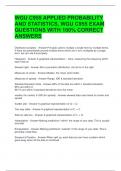Exam (elaborations)
WGU C955 APPLIED PROBABILITY AND STATISTICS, WGU C955 EXAM QUESTIONS WITH 100% CORRECT ANSWERS
- Course
- Institution
WGU C955 APPLIED PROBABILITY AND STATISTICS, WGU C955 EXAM QUESTIONS WITH 100% CORRECT ANSWERS Distributive property - Answer-Principle used to multiply a single term by multiple terms. If there are parenthesis around multiple terms which are in turn multiplied by a single term, we can use this p...
[Show more]



